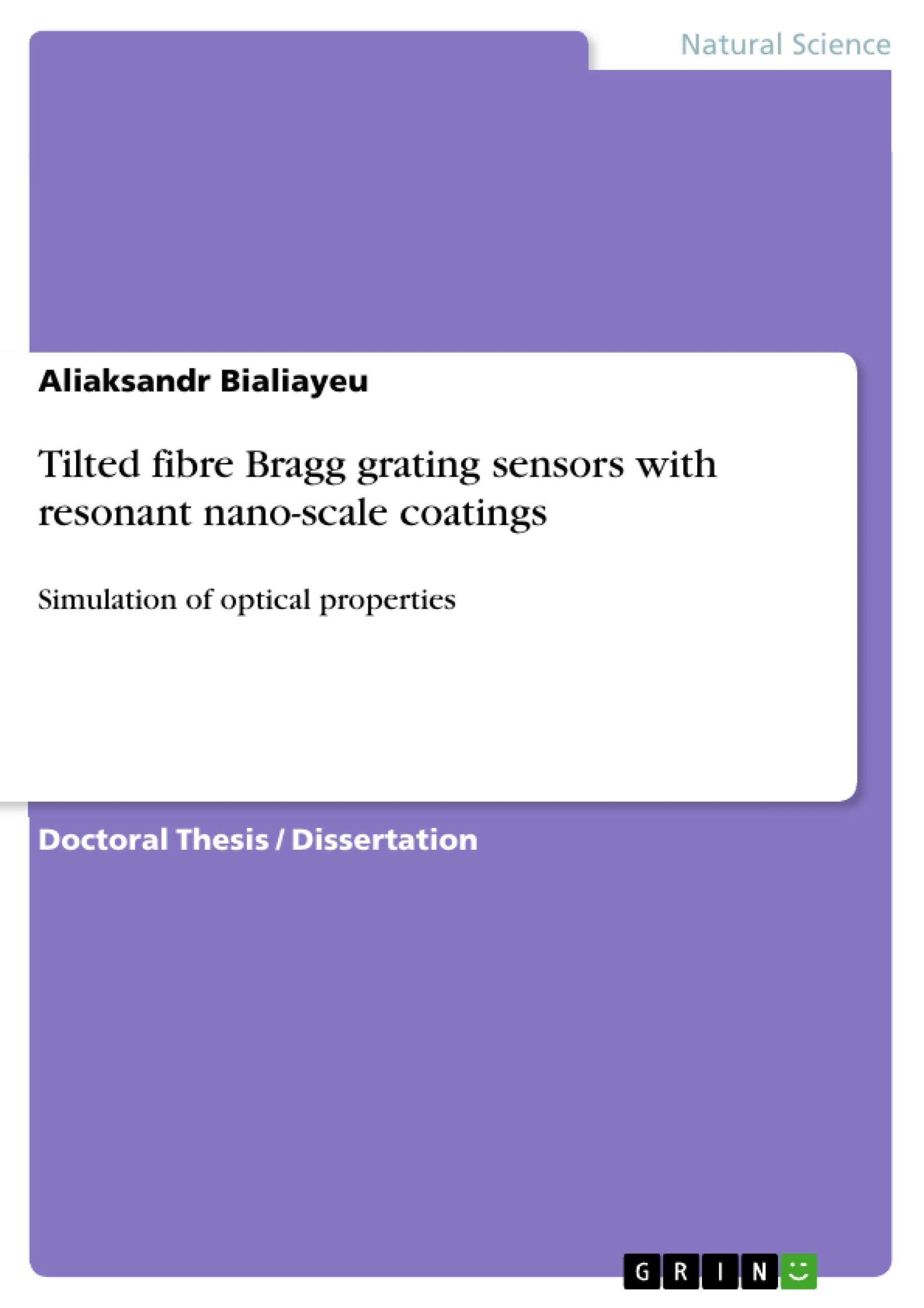Fibre Bragg grating sensors have emerged as a simple, inexpensive, accurate, sensitive and reliable platform, a viable alternative to the traditional bulkier optical sensor platforms.
In this work we present an extensive theoretical analysis of the tilted fibre Bragg grating sensor (TFBG) with a particular focus on its polarization-dependent properties.
We have developed a highly efficient computer model capable of providing the full characterization of the TFBG device in less then $3$~minutes for a given state of incident light polarization. As a result, the polarization-dependent spectral response, the field distribution at the sensor surface as well as the fine structure of particular resonances have become accessible for theoretical analysis.
As a part of this computer model we have developed a blazingly fast full-vector complex mode solver, capable of handling cylindrical waveguides of an arbitrary complex refractive index profile.
Along with the theoretical study we have investigated optical properties of the TFBG sensor with application to polarisation-resolved sensing.
We proposed a new method of the TFBG data analysis based on tracking the grating transmission spectra along its principle axes, which were extracted from the Jones matrix.
In this work we also propose a new method of enhancing the TFBG sensor refractometric sensitivity limits, based on resonant coupling between the TFBG structure resonances and the local resonances of nanoparticles deposited on the sensor surface. The $3.5$-fold increase in the TFBG sensor sensitivity was observed experimentally.
Frequently asked questions about "TILTED FIBRE BRAGG GRATING SENSORS WITH RESONANT NANO-SCALE COATINGS"
What is the main topic of this document?
This document is a language preview of a work titled "TILTED FIBRE BRAGG GRATING SENSORS WITH RESONANT NANO-SCALE COATINGS," focusing on the simulation of optical properties for such sensors. It includes the title, table of contents, objectives and key themes, chapter summaries, and keywords.
What is a Tilted Fibre Bragg Grating (TFBG) sensor?
A TFBG sensor is based on a standard telecommunication fiber with a tilted grating inscribed inside its core. This allows for the coupling of forward-propagating light from the core to backward-propagating cladding modes, making it sensitive to external refractive index changes.
What are the key themes explored in this document?
Key themes include the simulation of optical properties of TFBG sensors, modeling tilted Bragg grating structures, experimental polarization-based optical sensing with TFBG sensors, optical properties of materials and nanoparticles, optimizing parameters for nanoparticle-based coatings, and modifying sensor surfaces with nano-scale coatings.
What does the document say about enhancing TFBG sensor sensitivity?
The document explores sensitivity enhancement through resonant coupling between TFBG resonances and the local resonances of nanoparticles deposited on the sensor surface, as well as through modification of the sensor surface with nano-scale coatings.
What numerical methods are discussed for analyzing waveguides?
The document discusses the use of a full-vector complex mode solver for circularly symmetric optical waveguides. It also mentions finite difference (FDM), finite element (FEM), and discrete dipole approximation (DDA) methods.
What is the free-electron model, and how does it relate to metal optics?
The document mentions the free-electron model as an approximation for the optical properties of metals, where electrons are treated as free particles. It notes that this model has limitations and that interband absorption becomes important at higher energies.
What is the Kramers-Kronig relation, and how is it used?
The Kramers-Kronig (KK) relations are mentioned as a way to connect the real and imaginary parts of the refractive index, allowing for one parameter to be deduced if the other is known across a wide frequency range.
What experimental techniques are mentioned for characterizing TFBG sensors?
Experimental techniques mentioned include using a spectrophotometer with a polarization controller to measure transmission spectra, as well as measuring Stokes parameters and Jones matrices with an optical vector analyzer (OVA).
What was the outcome of applying silver nanowire coating to TFBG sensors?
The experimental results from the language review indicate that coating a TFBG sensor with silver nanowires can improve the sensitivity by about 3.5 times relative to the uncoated TFBG sensor. The technique took advantage of a self-assembly process.
What is the Discrete Dipole Approximation (DDA) or Coupled Dipole Approximation(CDA) method used for?
The Discrete Dipole Approximation (DDA) method or Coupled Dipole Approximation (CDA) method are numerical methods for computing the scattering and absorption of light by particles with arbitrary shapes.
- Quote paper
- Aliaksandr Bialiayeu (Author), 2014, Tilted fibre Bragg grating sensors with resonant nano-scale coatings, Munich, GRIN Verlag, https://www.grin.com/document/293578



